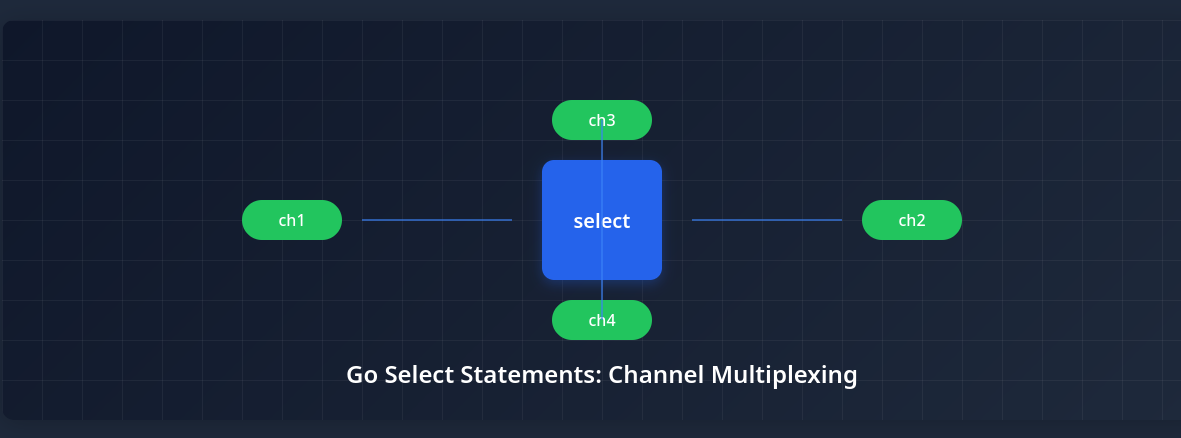Introduction
Go's select statement is a powerful control structure designed specifically for handling multiple channel operations. It enables a goroutine to wait on multiple communication operations simultaneously, making it a fundamental tool for concurrent programming. Unlike switch statements, select is specifically designed for channel operations and is one of Go's most distinctive features.
What is Channel Multiplexing?
Channel multiplexing allows a program to manage multiple channels of communication simultaneously, similar to how a TV remote can switch between different channels. In Go, the select statement is our channel-switching mechanism. This becomes particularly important when building scalable concurrent systems that need to handle multiple data streams or events.
Basic Syntax and Usage
select {
case operation1:
// code for operation1 case operation2:
// code for operation2 default:
// optional default operation }
Key Features of Select
1. Non-blocking Operations
select {
case msg := <-channel1:
fmt.Println("Received from channel1:", msg)
case channel2 <- data:
fmt.Println("Sent to channel2")
default:
fmt.Println("No channel operations ready")
}
2. Random Selection
When multiple channels are ready, select chooses one at random, ensuring fairness in channel selection.
func fairSelection() {
ch1 := make(chan string)
ch2 := make(chan string)
go func() {
ch1 <- "First" ch2 <- "Second" }()
select {
case msg1 := <-ch1:
fmt.Println(msg1)
case msg2 := <-ch2:
fmt.Println(msg2)
}
}
3. Timeouts and Cancellation
func timeoutOperation(ch chan string, timeout time.Duration) (string, error) {
select {
case result := <-ch:
return result, nil case <-time.After(timeout):
return "", fmt.Errorf("operation timed out after %v", timeout)
case <-ctx.Done():
return "", fmt.Errorf("operation cancelled")
}
}
Advanced Patterns
1. Done Channel Pattern
func worker(done chan bool, inputs <-chan int) {
for {
select {
case <-done:
fmt.Println("Worker received done signal")
return case input := <-inputs:
process(input)
}
}
}
2. Fan-in Pattern with Multiple Channels
func fanIn(channels ...<-chan string) <-chan string {
combined := make(chan string)
var wg sync.WaitGroup
// Function to forward messages forward := func(c <-chan string) {
defer wg.Done()
for msg := range c {
combined <- msg
}
}
wg.Add(len(channels))
for _, c := range channels {
go forward(c)
}
// Close combined channel when all input channels are done go func() {
wg.Wait()
close(combined)
}()
return combined
}
3. Rate Limiting with Buffered Channels
func rateLimiter(requests <-chan int, limit time.Duration) <-chan int {
limiter := make(chan int, 1)
go func() {
ticker := time.NewTicker(limit)
defer ticker.Stop()
for req := range requests {
select {
case <-ticker.C:
limiter <- req
default:
fmt.Println("Request dropped due to rate limiting")
}
}
}()
return limiter
}
Real-World Example: Event Handler System
type EventHandler struct {
events chan Event
errors chan error
done chan struct{}
timeout time.Duration
processor EventProcessor
}
func (h *EventHandler) Run() {
for {
select {
case event := <-h.events:
if err := h.processor.Process(event); err != nil {
h.errors <- err
}
case err := <-h.errors:
h.handleError(err)
case <-time.After(h.timeout):
h.performHealthCheck()
case <-h.done:
fmt.Println("Event handler shutting down")
return }
}
}
Best Practices and Guidelines
- Channel Direction
- Always specify channel direction when possible
- Use
<-chanfor receive-only channels - Use
chan<-for send-only channels
- Error Handling
select {
case err := <-errChan:
if err != nil {
log.Printf("Error received: %v", err)
// Handle error appropriately }
case data := <-dataChan:
process(data)
}
- Resource Cleanup
func cleanup(chans ...chan interface{}) {
for _, ch := range chans {
close(ch)
}
}
- Context Usage
func worker(ctx context.Context, tasks <-chan Task) {
for {
select {
case <-ctx.Done():
return case task := <-tasks:
processTask(task)
}
}
}
Common Pitfalls and Solutions
- Deadlocks
// Bad - potential deadlock select {
case ch <- data:
// This might block forever }
// Good - use timeout or default select {
case ch <- data:
// Data sent successfully case <-time.After(time.Second):
// Handle timeout default:
// Handle when channel is not ready }
- Goroutine Leaks
// Prevent leaks with done channel func preventLeak(done chan struct{}) {
ticker := time.NewTicker(time.Second)
defer ticker.Stop()
for {
select {
case <-done:
return case <-ticker.C:
// Do work }
}
}
Performance Considerations
- Buffer Sizing
- Consider channel buffer size based on expected load
- Monitor channel behavior in production
- Use buffered channels when performance is critical
- Select Statement Overhead
- Each
selectstatement has a small overhead - Avoid deeply nested select statements
- Consider combining channels when appropriate
- Each
Conclusion
The select statement is a cornerstone of Go's concurrency model, providing elegant solutions for managing multiple channel operations. Its ability to handle multiple channels simultaneously makes it invaluable for building robust concurrent systems. When used correctly, it enables:
- Non-blocking channel operations
- Graceful timeout handling
- Clean cancellation patterns
- Efficient resource management
- Scalable concurrent architectures
Understanding and mastering select is crucial for any Go developer working with concurrent systems. By following the patterns and practices outlined in this article, you can build more reliable and efficient concurrent applications.
Remember:
- Always handle timeouts and cancellation
- Use appropriate channel directions
- Implement proper error handling
- Clean up resources correctly
- Test concurrent code thoroughly
The select statement, combined with Go's other concurrency primitives, provides a powerful toolkit for building modern, concurrent applications that can handle complex communication patterns efficiently and reliably.
